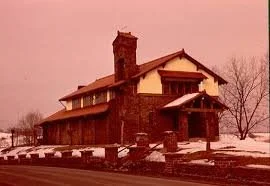Built It on Prayer: An Oral History of St. Pious (Moxie Manor)
Welcome to Moxie Manor …
Editor’s Note: The voices below are drawn from parish reports, local histories, newspaper notices, and present-day residents—condensed and arranged to read like a living conversation across time. Dates and key facts reflect the historical record; names are used only where published.
The Farmer (1850s):
“They said two acres would do. We worked the western edge of Pleasant Township, and when the land was given in ’52, we set our minds to raise a church under St. Pious. By ’54, we had it—timbers up at South Fork, Mass when the priest could ride out.”
Early Beginnings:
St. Pious began at South Fork (land donated 1852; church dedicated 1854), moved into town with a new Spanish-Mission church in 1908–09, and lived as a small but stubborn mission through boom, bust, and out-migration. It closed in 1989, was sold a decade later, and has spent the 21st century as a private residence and creative space—today known as Moxie Manor. Meanwhile, the South Fork cemetery—where the first church stood—was legally transferred to township trustees in 2001 and remains the anchor of the earliest story. Diocese of Columbus
The Archivist:
“Those earliest Catholics—Slevins, Sheerans, Rileys, O’Connors, Malloys, Carrolls, and more—formed the St. Pious mission at South Fork. Dominicans tended it first; later the diocesan priests from New Lexington and McLuney (Crooksville). In the 1880s it held perhaps 25 to 40 families.”
The Town Maker (1870s):
“Moxahala was platted in 1873; iron came, then the railroad, potteries, timber. For a time, the blast furnace meant pay in every pocket. Then it left for Columbus in 1897, and coal took over.”
George & Mary Forquer (early 1900s):
“Take our ground by the state road,” they told the mission, “build closer to town.” A Spanish-Mission design by Frank S. Gleichauf went up in 1908. First Mass: Christmas morning, 5 a.m. Bishop Hartley dedicated the church the next May. Cost about $6,000, with families carrying loans on their own credit—made good by parish picnics clearing over $1,000 those first years.”
Fr. B. J. Mattes (pastor from Crooksville, 1906–1918):
“I rode over twice a month in fair seasons, once in the bad. Salary often in arrears, but the people were faithful.”
The Church Committee (1920):
“We painted the exterior, brightened the sanctuary, set twelve emblems on the walls, and hung a life-sized Garden of Gethsemane. The altars were refashioned in onyx. We also organized a cemetery society for the old South Fork grounds.”
The Land Man (1922–23):
“More acres were deeded to the Bishop—extending the lot to the T&OC railroad. In the end the church sat on nearly five acres, grounds sweeping up to the road.”
The Accountant (Great Depression):
“Collections and pew rents shrank. Card parties and that picnic kept the lights on. The mines sputtered; families left.”
Bishop Hartley (1943, recalling a visit):
“She stands with a welcome—approach wide, grounds handsome, few families but proud.”
Fr. Lucius Kessler (1931–1949):
“When I began, fifty families; by ’46, eight—and parts of eight. The rest moved to cities for work.”
The School Mother (1950s–60s):
“Our children rode a donated bus so they could attend St. Bernard’s in Corning. The yearly budget: the driver, repairs, insurance—more than half of what the mission took in. In ’59 we bought a new bus for $5,000 with a loan from St. Rose.”
The Census Taker (mid-1970s–80s):
“Still coal country. Older folks stayed; younger ones left. By the mid-80s, forty-eight souls on the rolls.” Diocese of Columbus
The Diocesan Planner (1988–89):
“Perry County parishes entered a consortium to share priests. St. Pious would close June 1, 1989—delayed to August. Bishop Griffin offered the last public Mass on August 20; the mission closed August 31.”
The Auctioneer (1999):
“In the mid-’90s, the property was put up for sale. It sold in August 1999 for $35,000.” Diocese of Columbus
The Glassmaker (early 2000s):
“I turned the old nave into a home and studio. Our pieces traveled—across the States, Canada, Europe, even Australia. The church, now, was simply a residence.”
The Cemetery Caretaker (South Fork):
“The old site was neglected for a time—vandalism, weeds, broken stones. Descendants rallied after 1950; fencing went up. In 2001, the township finally received the deed to manage and sell new lots on the west side. The base under Mary’s statue? Steps and foundation stones from the old church.” Diocese of Columbus
The Postcard Collector:
“Here—an image of St. Pious, Moxahala, circa 1907–1910. Proof in sepia that it stood proud when the parish was young.” eBayHipPostcard
A Horror Writer (Jerry Roth) becomes the owner (2020):
“I bought a 1908 Catholic church in Moxahala and made it my home—called it Moxie Manor. A place with a past like a second skin. For a horror writer, the walls whisper.” readersentertainment.com
Moxie Manor ~2020
Moxie Manor 2024








